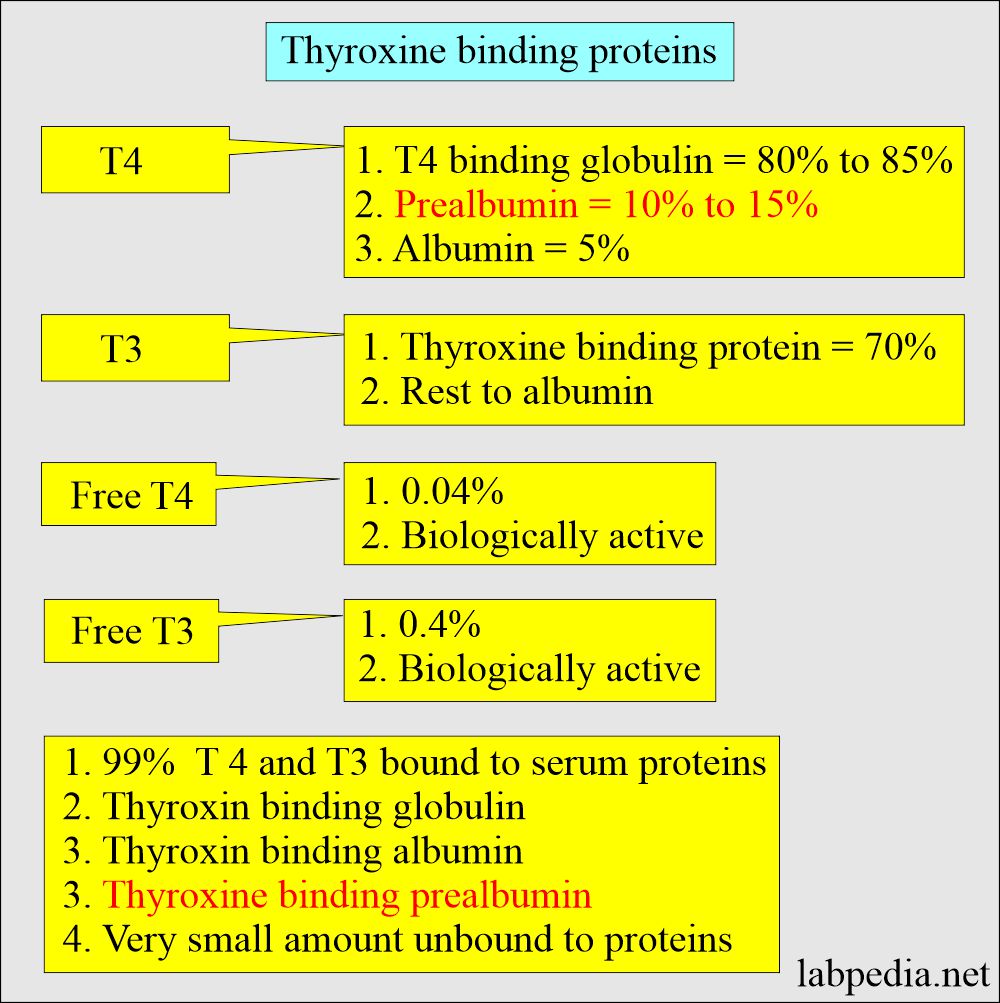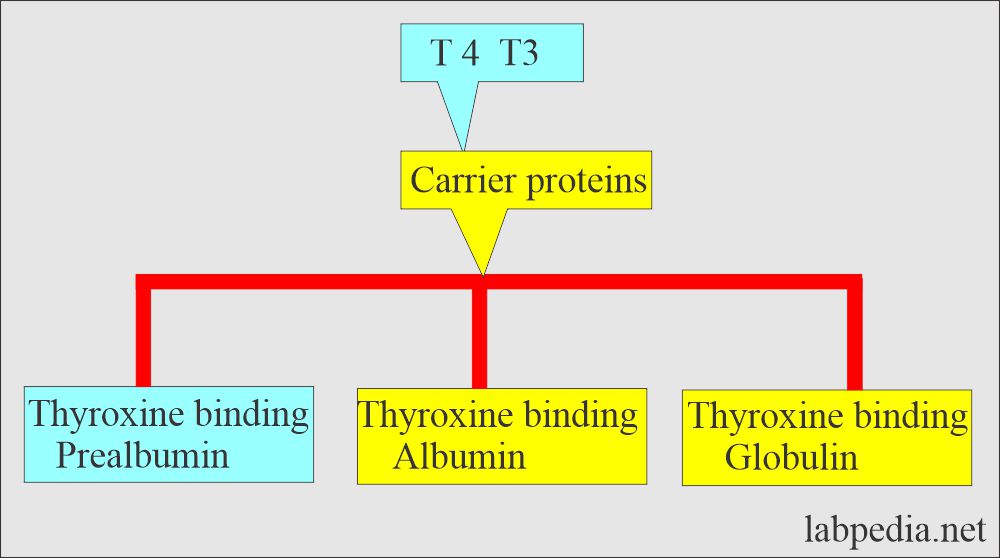Thyroid:- Part 4 – Thyroxine-Binding Prealbumin (TBPA), Transthyretin, Thyretin
Thyroxine-Binding Prealbumin (TBPA)
What sample is needed for Thyroxine-Binding Prealbumin?
- The serum of the patient is needed.
- Analyze the sample fresh or store it at 4 °C for <72 hours.
- At -20 °C, the serum is stable for 6 months.
- Avoid serum with lipemia or hemolysis.
What are the Indications for Thyroxine-binding prealbumin?
- Transthyretin is advised to differentiate hyperthyroidism from hypothyroidism.
- Genetic variants Transthyretin are associated with decreased or increased T4 and T3.
- Prealbumin estimation Is advised to work up malnutrition.
- Prealbumin is a better indicator of liver function than albumin.
How will you define the structure of Thyroxine-Binding Prealbumin (Transthyretin)?
- Prealbumin is synthesized in the liver and is found in the blood and CSF.
- Prealbumin is the fastest-migrating protein in serum electrophoresis. However, it is not seen on the electrophoresis, and there is a faint band.
- Prealbumin binds the thyroxine, so-called thyroxine-binding prealbumin (TBPA).
- Thyroxine-binding prealbumin has a molecular weight of 50,000 D.
- Transthyretin is known as prealbumin binding the thyroid hormones.
- Transthyretin is prealbumin that carries the thyroid hormones (T4 and T3) in the blood and CSF.
- So, it transports thyroxine and retinol.
How will you interpret Thyroxin-binding prealbumin (Transthyretin)?
- T4 and T3 are poorly soluble in the plasma, so they are transported by thyroglobulin and 15% by albumin and prealbumin.
- The prealbumin transports 10% of thyroid hormones.
- Thyroxine is 99% bound to Thyroid-binding globulin, albumin, and prealbumin.
- Transthyretin, known as prealbumin, has a half-life of 48 hours (1.9 days).
- This TBPA does not play a major role in thyroid hormone functions.
- Prealbumin is secondary to thyroxine-binding globulin (TBG) for transporting T3 and T4.
- Zinc is needed for the synthesis of prealbumin. A low Zinc level also lowers the amount of prealbumin.
- Prealbumin also affects the transportation and metabolism of vit. A.
What is the role of transthyretin (prealbumin) in thyroid diseases?
- Transthyretin binds to T4, so changes in the Transthyretin level can affect the amount of T4 in the body’s tissues.
- Hyperthyroidism:
- Low Transthyretin level can lead to an increase in the T4 level, resulting in hyperthyroidism.
- Hypothyroidism:
- In case of an increased level of transthyretin leads to a decreased T4 level (free T4), and the end result is hypothyroidism.
How will you interpret Prealbumin?
- Previously, albumin was the marker of malnutrition and is now replaced by prealbumin.
- The albumin half-life is 21 days, while the half-life of prealbumin is 2 days (1.9 days).
- Its short half-life is the more sensitive indicator of any change affecting protein synthesis.
- This is the marker in the case of parenteral nutrition.
- There will be a marked decrease in the prealbumin level in liver diseases.
- Prealbumin is decreased in inflammation, malignancies, and protein-losing diseases of the kidneys and intestine, so it is a negative acute-phase protein reactant.
- Prealbumin will be raised in Hodgkin’s lymphoma and chronic kidney diseases.
- Prealbumin can cross the blood-brain barrier, so it is found in the CSF.
What is the normal Thyroxine-Binding Prealbumin (Transthyretin)?
Source 1
Transthyretin (Thyroxine-binding prealbumin)
| Age | mg/dL |
| Cord blood | 13 |
| One year | 10 |
| Maternal | 23 |
| Adult | 10 to 40 |
| Male | 21.5 |
| Female | 18.2 |
Source 2
Normal Prealbumin level:
- Adult/elders = 15 to 36 mg/dL.
- Children <5 days = 6 to 21 mg/dL.
- 1 to 5 years = 14 to 30 mg/dL.
- 6 to 9 years = 15 to 33 mg/dL.
- 10 to 13 years = 22 to 36 mg/dL.
- 14 to 19 years = 22 to 45 mg/dL
- Urine = 0.017 to 0.047 mg/day
- CSF = roughly 2% of the total CSF protein.
What are the causes of increased Thyroxine-binding prealbumin (Transthyretin)?
- In the case of high doses of corticosteroids.
- Nonsteroidal anti-inflammatory drugs.
- Hodgkin’s disease.
- Adrenal hyperactivity.
What are the causes of decreased Tryroxin-binding prealbumin (Transthyretin)?
- It is a very sensitive negative acute-phase protein. It may drop to <20% of the median level.
- It falls during calorie-protein malnutrition.
- It is also seen in several forms of hereditary amyloidosis.
Prealbumin
What are the causes of the increase in the level of Prealbumin?
- Hodgkin’s disease.
- Nephrotic syndrome (some of the cases).
- Pregnancy.
- Anabolic steroids, androgens, estrogen, and prednisone may increase the value.
What are the causes of decreased levels of Prealbumin?
- Malnutrition.
- Liver diseases.
- Inflammation.
- Burns.
- Drugs may decrease the level of oral contraceptives and amiodarone.
- The critical value of prealbumin is <10.7 mg/dL, indicating severe malnutrition.
How will you differentiate different thyroid diseases?
| Clinical disease | Free T4 | Total T4 | T3 | TSH | Thyroglobulin |
| Hyperthyroidism primary clinical | Increased | Increased | Increased | Decreased | Normal |
| Hyperthyroidism subclinical | Normal | Normal | Normal | Decreased | Normal |
| Hypothyroidism primary clinical | Decreased | Decreased | Decreased | Increased | Normal/Increased |
| Hypothyroidism primary subclinical | Normal | Normal | Normal | Increased | Normal |
| Hypothyroidism Secondary | Decreased | Decreased | Decreased | Normal/Decreased | |
| T3 thyrotoxicosis | Normal | Normal | Increased | Decreased | Normal |
| TSH-secreting tumors | Increased | Increased | Increased | Increased | Normal |
| Pregnancy with hyperthyroidism | Increased | Increased | Increased | Normal | Increased |
| Pregnancy with hypothyroidism | Decreased | Increased | Increased | Increased | Increased |
| Goiter | Normal | Normal | Normal | Normal | Normal |
| Thyroid carcinoma | Normal | Normal | Normal | Normal | Increased |
| Hashimoto’s thyroiditis | Variable | Variable | Variable | Variable | |
| Nephrosis | Decreased | Decreased | Normal | Decreased |
Questions and answers:
Question 1: What is the site of prealbumin synthesis and its function?
Question 2: Can we see prealbumin on electrophoresis?



